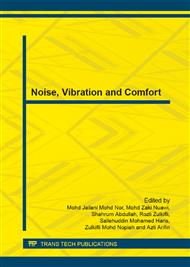p.35
p.40
p.45
p.52
p.59
p.64
p.69
p.74
p.81
Measurement of Noise inside the Compartment and Vibration on both Sides of Elastomeric Powertrain Mounts of Passenger Car
Abstract:
This paper presents an evaluation on elastomeric mount used to isolate vibration from powertrain to chassis or structure vehicle. The assessments started with measurement of noise inside compartment, and exhaust noise. This is followed by the measurement of vibration on both sides of elastomeric mounts. The noise in the compartment and exhaust noise is measured according to BS 6086: 1981 and BS ISO 5130: 2007. The noise in the compartment and vibration is tested in three conditions. Firstly, engine is run-up with load (driving at second gear); secondly, without load; and thirdly, without load but hanging. A microphone is fixed at the ear of the mannequin. The fast response and A weighting sound level meter were used for measurement noise in the compartment and exhaust noise. The vibration is measured in terms of acceleration on both sides of each elastomeric powertrain mounts. Two accelerometer transducers are fixed on both sides of powertrain elastomeric mounts. One side was identified as a source of vibration and the other as receiver of vibrations. The results showed that the pattern of overall vibration level on source and receiver increased from 1050 RPM (idling) to 4000 RPM on all test conditions. Vibration transmitted to chassis or receiver structure was analyzed using transmissibility concept. By evaluating test condition of engine run-up without load, informed that the front and rear mounts showed a high level transmissibility contributing to structure-borne noise.
Info:
Periodical:
Pages:
59-63
Citation:
Online since:
December 2013
Price:
Сopyright:
© 2014 Trans Tech Publications Ltd. All Rights Reserved
Share:
Citation:


